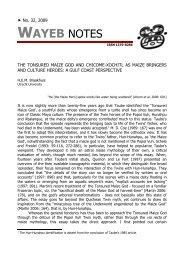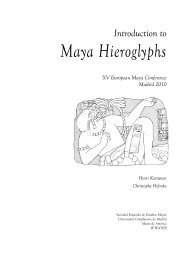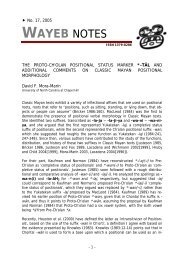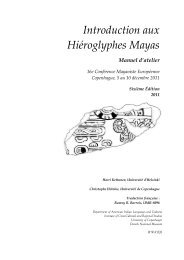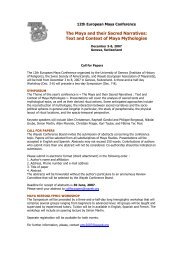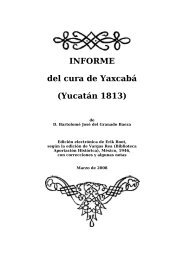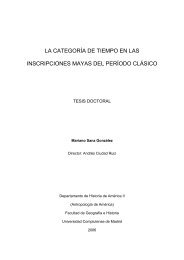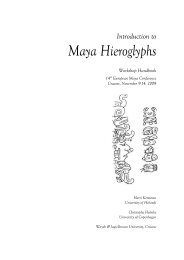Introduction to Maya Hieroglyphs - Wayeb
Introduction to Maya Hieroglyphs - Wayeb
Introduction to Maya Hieroglyphs - Wayeb
Create successful ePaper yourself
Turn your PDF publications into a flip-book with our unique Google optimized e-Paper software.
Kettunen & Helmke 2011<br />
Glossary of Linguistic Terminology<br />
processes of transcription). The reconstructive approach does not require the stipulation of phonetic reversal, a<br />
process which is no longer believed <strong>to</strong> have existed.<br />
nasal<br />
A feature which characterizes sounds that are produced by lowering the soft palate (velum), allowing the air <strong>to</strong><br />
escape through the nose. In the Classic <strong>Maya</strong> language there are two nasal sounds (nasal consonants): [m] and [n].<br />
nominal structure<br />
Structures that are grammatically comparable <strong>to</strong> nouns. Nominal structures include noun STEMS, NOUNS,<br />
PRONOUNS, noun phrases and nominal clauses. They are the most fundamental categories for the construction of<br />
syntactic arrangements along with verbal structures.<br />
nominal class<br />
A general term indicating the fact that e.g. NOUNS, VERBS, and PRONOUNS can belong <strong>to</strong> different MORPHOLOGICAL<br />
classes. In quite a few languages nouns fall in<strong>to</strong> two or three classes: masculine, feminine, and neuter, with each<br />
of them INFLECTED differently. In English there is no such distinction, and in the <strong>Maya</strong> languages the only<br />
‘genderized’ grammatical class is that of male (masculine) and female (feminine) classifiers that are sometimes<br />
(rather inaccurately) referred <strong>to</strong> as agentives: aj- (masculine classifier), and ix- (feminine classifier). Neither of<br />
these actually refer <strong>to</strong> the male or female gender per se: the masculine classifier is actually a neutral classifier and<br />
it can be found attached <strong>to</strong> a number of plant and animal names and the feminine classifier can also work as a<br />
diminutive. However, when it comes <strong>to</strong> pronouns, the English language has gender in the third person pronouns<br />
(“he”, “she”, and “it”, “his”, “her”, and “its”) but some other languages such as Finnish or the <strong>Maya</strong> languages<br />
do not. In Classic <strong>Maya</strong> the pronoun u- (before words starting with consonants) and y- (before words starting<br />
with vowels) operate both for men and women (“he”, “she”, “it”, “his”, “her”, and “its”). In <strong>Maya</strong> languages, the<br />
gender of the person referred <strong>to</strong> in an utterance has <strong>to</strong> be indicated otherwise (if needed) stating the gender using<br />
classifiers (aj- / ix-) or nouns such as “man”, “father”, “woman”, “grandmother”, etc. This is also the case in<br />
Finnish – with the exception that not even masculine or feminine classifica<strong>to</strong>rs exist in the language. As a result,<br />
the gender of the person one is referring <strong>to</strong> has <strong>to</strong> be elucidated through oblique queries.<br />
noun<br />
One of the major lexical categories: a word that names an entity, whether a person, an object, an idea, or a place.<br />
Nouns can function as SUBJECTS or OBJECTS of a VERB.<br />
number<br />
A linguistic category of NOUNS and PRONOUNS that indicates the quantity of referred individuals. In the Classic<br />
<strong>Maya</strong> there are two numbers: SINGULAR (sg. or S) and PLURAL (pl. or P) whereof the singular is by far the most<br />
common with pronouns. Since the plural SUFFIX is optional in <strong>Maya</strong> languages (usually present only when the<br />
plural form needs <strong>to</strong> be emphasized), the absence of plural suffixes is observable also in the script. However,<br />
there are some cases in the corpus where the plural suffix –ob (–o’b / –oob) is marked for the demonstrative<br />
pronoun ha’i’ (“that”) <strong>to</strong> yield ha’ob (ha’o’b / ha’oob; “those”), as in the example below from Copan Temple 11 87 :<br />
ha-o-bo<br />
ha’ob / ha’o’b / ha’oob<br />
ha’-ob-Ø<br />
DEM.PRO-PL-3PA<br />
“they are”<br />
ko-ko-no-ma<br />
ko[h]knom<br />
ko[h]k-n-om-Ø<br />
guard-APAS-AG-3PA<br />
“[the] guardians”<br />
87<br />
We wish <strong>to</strong> thank Marc Zender for pointing out this reference and providing the linguistic data for it.<br />
138/154



